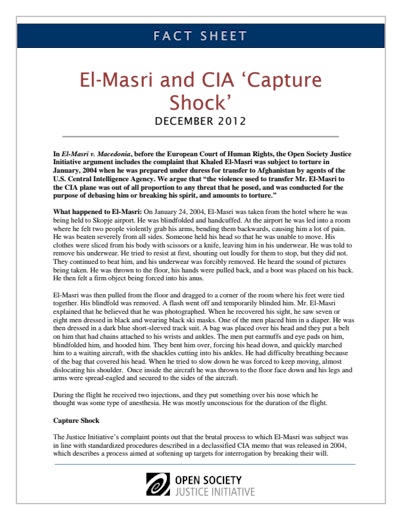El-Masri and CIA 'Capture Shock'
In El-Masri v. Macedonia, before the European Court of Human Rights, the Open Society Justice Initiative argument includes the complaint that Khaled El-Masri was subject to torture in January, 2004 when he was prepared under duress for transfer to Afghanistan by agents of the U.S. Central Intelligence Agency. We argue that “the violence used to transfer Mr. El-Masri to the CIA plane was out of all proportion to any threat that he posed, and was conducted for the purpose of debasing him or breaking his spirit, and amounts to torture.”
What happened to El-Masri: On January 24, 2004, El-Masri was taken from the hotel where he was being held to Skopje airport. He was blindfolded and handcuffed. At the airport he was led into a room where he felt two people violently grab his arms, bending them backwards, causing him a lot of pain. He was beaten severely from all sides. Someone held his head so that he was unable to move. His clothes were sliced from his body with scissors or a knife, leaving him in his underwear. He was told to remove his underwear. He tried to resist at first, shouting out loudly for them to stop, but they did not. They continued to beat him, and his underwear was forcibly removed. He heard the sound of pictures being taken. He was thrown to the floor, his hands were pulled back, and a boot was placed on his back. He then felt a firm object being forced into his anus.
El-Masri was then pulled from the floor and dragged to a corner of the room where his feet were tied together. His blindfold was removed. A flash went off and temporarily blinded him. Mr. El-Masri explained that he believed that he was photographed. When he recovered his sight, he saw seven or eight men dressed in black and wearing black ski masks. One of the men placed him in a diaper. He was then dressed in a dark blue short-sleeved track suit. A bag was placed over his head and they put a belt on him that had chains attached to his wrists and ankles. The men put earmuffs and eye pads on him, blindfolded him, and hooded him. They bent him over, forcing his head down, and quickly marched him to a waiting aircraft, with the shackles cutting into his ankles. He had difficulty breathing because of the bag that covered his head. When he tried to slow down he was forced to keep moving, almost dislocating his shoulder. Once inside the aircraft he was thrown to the floor face down and his legs and arms were spread-eagled and secured to the sides of the aircraft.
During the flight he received two injections, and they put something over his nose which he thought was some type of anesthesia. He was mostly unconscious for the duration of the flight.
Capture Shock
The Justice Initiative’s complaint points out that the brutal process to which El-Masri was subject was in line with standardized procedures described in a declassified CIA memo that was released in 2004, which describes a process aimed at softening up targets for interrogation by breaking their will.
The CIA memo demonstrates that the method by which Mr. El-Masri was brought into U.S. custody was carefully designed to give rise to a state of “capture shock” with the goal of inducing a state of “learned helplessness and dependence,” conducive to effective interrogation upon arrival at the black site in Afghanistan. The memo specifically authorizes many of the methods that were used against Mr. El-Masri: “During the flight, the detainee is securely shackled and is deprived of sight and sound through the use of blindfolds, earmuffs, and hoods” in order to “contribute to the physical and psychological condition of the [High Value Detainee] prior to the start of interrogation.” It authorizes other techniques used against him such as “walling” (slamming him against a wall), “cramped confinement” and “stress positions”.
The memo makes clear that the strategic aim of all interrogation and transport methods was to use both “physical and psychological pressures in a comprehensive, systematic, and cumulative manner to influence [detainees’] behavior, to overcome a detainee’s resistance posture,” that is, breaking their physical and moral resistance.”
Macedonia’s responsibility
Under the UN Convention against Torture, states are not only prohibited from torture, but are also prohibited from “complicity” or “participation” in torture. In considering a joint US-Egyptian rendition operation at a Stockholm airport in 2001, the UN Human Rights Committee decided that Swedish officials were culpable because they had allowed a similar rendition procedure to be carried out at a Swedish airport in the presence of Swedish officials. We argue that “the Macedonian authorities had a positive obligation to prevent the clear ill-treatment that was occurring in front of them, and are responsible for the torture that occurred at Skopje airport as a result”.
Topics
- Climate Justice
- Digital Rights and Fair Elections
- Discrimination and Racial Justice
- International Crimes
